|
McDermid Rock is very very old - the granite from which
it was formed dates from more than 2.6 billion years ago.
The same is true for Disappointment Rock, Bank Rock, Wave Rock and many other
similar outcrops in the Yilgarn Block, the geological feature that underlies
much of southern Western Australia.
The shape you see today is the result
of countless earthquakes, tremors and upheavals - and more
than a little weathering - through that vast span of time.
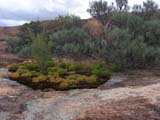
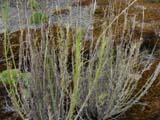
|
Like miniature gardens, "islands of vegetation" are
scattered across the rock face, supporting a surprisingly
rich array of life forms.
They develop wherever soil can gather in pockets, depressions or fissures in
the rock.
As soon as the soil build-up is adequate they are colonised by plants that are
often unique to the particular rock on which they are found.
In this case Calothamnus tuberosus is present,
as is the well known "resurrection bush" (Borya constricta),
but there are literally dozens more species in this
one small
"rockery".
Such is the opportunism of these plants that they will seize upon the slightest
prospect of life and - in a wink of time - a natural garden is born.
|
|
In Australia a rock basin is known as a
gnamma, an Aboriginal word meaning "rock hole".
They are
generally about a metre in diameter and roughly 15 cm
deep - though they can be several metres across and quite
deep.
So important were they in traditional lifestyles
that Aboriginal people are known to have visited certain
sites regularly, to keep favoured gnammas clean.
Some gnammas - especially
larger ones - hold water for a long time after a good
rain.
These long lasting gnammas
become focal points for life (both human and animal)
in times of heat and drought.
They form through the weathering action of water
trapped in small depressions in the rock surface.
This water
gradually breaks down and rots the rock that it is
in contact with, enlarging the basin as it does so.
They often form on joints in the rock, where water
can more readily penetrate the surface.
|
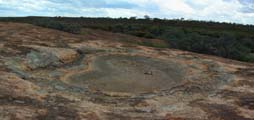
|
While pan "gnammas" are relatively common on McDermid
Rock this pan is unusual in that it is in
effect two pans, a "pan-in-a-pan", a secondary
pan that has eroded in the floor of the larger basin.
This is most likely the consequence of differing layers
in the rock strata.
The top layer is known as "laminated granite" - many
thin sheets stacked upon each other.
This has eroded out to form the larger outlying pan,
the base of which is grey granite.
The inner, hemispherical pan has formed in this "substrate",
despite its significant
hardness.
When full of water these pans burst into life, hosting
various crustaceans, frogs and other creatures,
all adapted to the short life cycle demanded by
the temporary
pool. |
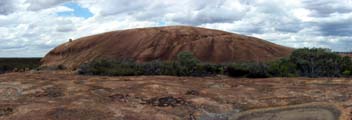
|
On the high shoulder of McDermid Rock one can see
a balancing boulder perched up there, like a flea on
an elephant.
How did it get there, and why does it not tumble off?
Isolated boulders such as this are most likely the result of the break up of
larger sheets into blocks, and the subsequent weathering and rounding of the
edges.
This theory may be supported by the jumble of broken blocks and slabs around
the base of the main rock.
The balancing boulder must have been either harder
or more firmly "planted" than
all its neighbours, to have remained alone on the face.
Whatever the reason, it has clung to its perch to become the signature image
of McDermid Rock.
Let's just hope it doesn't choose today to fall!
|
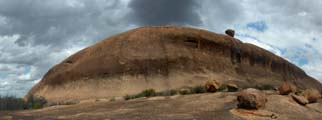
|
This scattering of loose boulders may well be the "siblings" of
the balancing rock up there on the rim.
It is likely that sometime in the distant past - perhaps
many millions of years ago - McDermid Rock wore another
layer (or sheet) of granite over what is now the surface.
Fracturing, weathering and then a good seismic shaking
might have tumbled these rocks down the slope.
Notice the surface that
almost looks like a series of chickenpox scars?
At least some of these indentations are plunge pools,
caused by water tumbling down the face in miniature
waterfalls.
Where the stream strikes the rock it gradually gouges a pock-mark - which,
when well developed, is known as a plunge pool. |
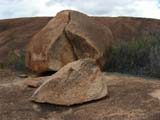
|
Most of the "shaping" of the various elements of McDermid
Rock are the result of some form of weathering. Water
is a major cause, whether liquid or frozen, flowing
or static.
Chemicals and biological organisms also contribute to weathering, usually in
tandem with water and wind.
This massive split rock
is probably the result of what started as no more than
a thin fracture.
This split perhaps formed along a weakness in the basic
rock structure or may have been the result of seismic
activity way back when this boulder was still part
of a much larger slab.
More than likely the crack was then prised open by
the immensely powerful action of ice forming and then
expanding in the split on cold nights.
Eventually - crack! - the whole thing broke asunder,
just like the two halves of a dropped watermelon.
|

|
Sometimes the terminology of geology can be daunting
indeed!
This line of large ragged crystals is known as a pegmatite
dike (dyke).
Pegmatite is a coarse grained igneous rock with exceptionally
big crystals, formed from a magma that contains a high
proportion of water.
And a dike is a vein injected across the base structure
of the host rock. So this stripe of chunky crystals
running up the rock face is a pegmatite dike.
|
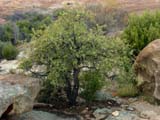
|
Some of the earliest Europeans to pass through this
country were the sandalwood cutters.
Following hard on the heels of gold prospectors and explorers they began combing
the arid inland way back in the mid 1800s.
It was trees such as the
lone specimen of Santalum spicatum nestling in the
cleft in the rocks that they were looking for.
The delightful aromatic timber from the sandalwood
tree is highly sought after in Asia, where it is made
into joss sticks used in religious ceremonies.
During the 1840s up to 45% of the fledgling Swan
River Colony's export income came from sandalwood.
It is still cut and exported today, but under tight control by the Department
of Conservation & Land Management.
Fortunately for us (and for the tree) this is the one that got away ... |
|